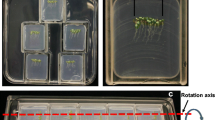Abstract
Utilization of orbiting spacecraft allows for studying biological processes in conditions of microgravity. Centrifuges on board these platforms also allow for the creation of partial gravity vectors (to simulate the Moon or Mars levels of gravity) as well as onboard 1-g controls for the space experiments. Thus, the mechanisms of gravity and light perception in plants can be analyzed in a unique environment which can give insights into fundamental processes in biology. Here, we describe the methods for preparation of a plant biology experiment with seedlings of Arabidopsis thaliana utilizing the European Modular Cultivation System (EMCS) on the International Space Station (ISS). The procedures outlined in this paper have been successfully used in several of our recent spaceflight experiments, which have given unique insights into the basic mechanisms of tropisms.
Access this chapter
Tax calculation will be finalised at checkout
Purchases are for personal use only
Similar content being viewed by others
References
Kiss JZ (2014) Plant biology in reduced gravity on the Moon and Mars. Plant Biol (Stuttg) 16:12–17
Vandenbrink JP, Kiss JZ, Herranz R, Medina FJ (2014) Light and gravity signals synergize in modulating plant development. Front Plant Sci 5:563
Herranz R, Valbuena MA, Youssef K, Medina F-J (2014) Mechanisms of disruption of meristematic competence by microgravity in Arabidopsis seedlings. Plant Signal Behav 9:124
Vandenbrink JP, Herranz R, Medina FJ, Edelmann RE, Kiss JZ (2016) A novel blue-light phototropic response is revealed in roots of Arabidopsis thaliana in microgravity. Planta 244:1201–1215
Wolverton C, Kiss JZ (2011) An update on plant space biology. Gravit Space Res 22:13–22
Buizer K (2007) GraPhoBox: gravitropism and phototropism in Arabidopsis thaliana. Microgravity Sci Technol 19:239–243
Ivanova T, Bercovich YA, Mashinskiy A, Meleshko G (1993) The first “space” vegetables have been grown in the “SVET” greenhouse using controlled environmental conditions. Acta Astronaut 29:639–644
Heathcote D, Brown A, Chapman D (1995) The phototropic response of Triticum aestivum coleoptiles under conditions of low gravity. Plant Cell Environ 18:53–60
Kraft TF, van Loon JJ, Kiss JZ (2000) Plastid position in Arabidopsis columella cells is similar in microgravity and on a random-positioning machine. Planta 211:415–422
Ferl RJ, Koh J, Denison F, Paul AL (2015) Spaceflight induces specific alterations in the proteomes of Arabidopsis. Astrobiology 15:32–56
Kiss JZ, Millar KDL, Edelmann RE (2012) Phototropism of Arabidopsis thaliana in microgravity and fractional gravity on the International Space Station. Planta 236:635–645
Kiss JZ (2015) Conducting plant experiments in space. Methods Mol Biol 1309:255–283
Blancaflor EB (2002) The cytoskeleton and gravitropism in higher plants. J Plant Growth Regul 21:120–136
Millar KD, Johnson CM, Edelmann RE, Kiss JZ (2011) An endogenous growth pattern of roots is revealed in seedlings grown in microgravity. Astrobiology 11:787–797
Correll MJ, Kiss JZ (2005) The roles of phytochromes in elongation and gravitropism of roots. Plant Cell Physiol 46:317–323
Correll MJ, Pyle TP, Millar KDL, Sun Y, Yao J, Edelmann RE, Kiss JZ (2013) Transcriptome analyses of Arabidopsis thaliana seedlings grown in space: implications for gravity-responsive genes. Planta 238:519–533
Smith RH (2013) Plant tissue culture: techniques and experiments, 3rd edn. Academic Press, Cambridge, MA
Author information
Authors and Affiliations
Corresponding author
Editor information
Editors and Affiliations
Rights and permissions
Copyright information
© 2019 Springer Science+Business Media, LLC, part of Springer Nature
About this protocol
Cite this protocol
Vandenbrink, J.P., Kiss, J.Z. (2019). Preparation of a Spaceflight Experiment to Study Tropisms in Arabidopsis Seedlings on the International Space Station. In: Yamamoto, K. (eds) Phototropism. Methods in Molecular Biology, vol 1924. Humana Press, New York, NY. https://doi.org/10.1007/978-1-4939-9015-3_17
Download citation
DOI: https://doi.org/10.1007/978-1-4939-9015-3_17
Published:
Publisher Name: Humana Press, New York, NY
Print ISBN: 978-1-4939-9014-6
Online ISBN: 978-1-4939-9015-3
eBook Packages: Springer Protocols




